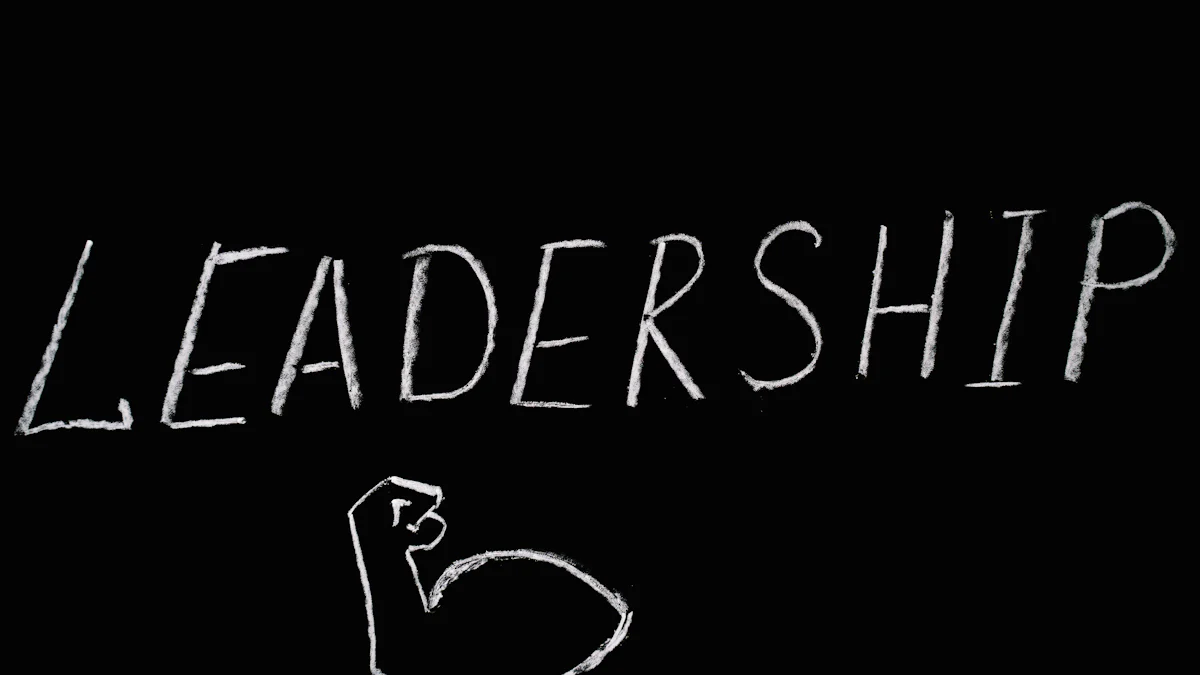Developing a successful organization

Understanding the critical components of a successful organization is essential for accelerating business development and achieving success. You must focus on the development and execution of strategies that align with your goals to effectively reach your goals. According to the Harvard Business Review, companies with strong cultures achieve organizational success more effectively. Dave Clark emphasizes that investing in leadership training is a critical component to organizational growth. By prioritizing these elements, you can achieve organizational success and reach your business goals. Harvard Business School Online suggests that a well-defined vision and strategic planning are vital for achieving success in today's competitive landscape.
Leadership and Vision

Leadership plays a pivotal role in shaping the future of any organization. You must understand the essence of effective leadership to drive your organization toward success. A clear vision, communicated effectively, can set your organization apart from others. According to the Institute for Management Development (IMD), organizations with leaders who communicate a clear, compelling vision outperform others by significant margins. This highlights the importance of leadership in achieving organizational goals.
Defining Leadership
Effective leadership involves more than just managing tasks. It requires inspiring and guiding your team toward a shared vision. You need to develop core competencies that enable you to lead with confidence and clarity.
Characteristics of Effective Leaders
Effective leaders possess certain characteristics that set them apart. They demonstrate integrity, resilience, and empathy. You should strive to embody these traits to inspire trust and loyalty within your team. By doing so, you create an environment where everyone feels valued and motivated to contribute their best.
Role of Vision in Leadership
Vision serves as the foundation of leadership. It provides direction and purpose. You must articulate a vision that resonates with your team and aligns with your organization's goals. The Balance emphasizes that executing leadership vision may be among the toughest core competencies for leaders to develop. However, mastering this skill can lead to remarkable outcomes.
Creating a Vision Statement
A well-crafted vision statement acts as a guiding star for your organization. It defines where you want to go and how you plan to get there. Developing a vision statement requires careful thought and consideration.
Steps to Develop a Vision Statement
Reflect on Your Goals: Consider what you want your organization to achieve in the long term.
Engage Your Team: Involve key stakeholders in the process to ensure alignment and buy-in.
Craft a Clear Statement: Use simple language to articulate your vision, making it easy for everyone to understand and remember.
Communicate Effectively: Share your vision with your team regularly to keep it at the forefront of their minds.
Aligning Vision with Organizational Goals
Your vision should not exist in isolation. It must align with your organizational goals to ensure coherence and focus. You need to regularly review and adjust your vision to reflect changes in the business environment. This alignment ensures that every action taken by your team contributes to the overarching objectives of your organization.
Strategic Planning
Strategic planning serves as the backbone of any successful organization. It provides a roadmap for achieving your long-term goals and ensures that every action aligns with your overarching objectives. By engaging in effective strategic planning, you can position your organization for sustained success.
Importance of Strategic Planning
Strategic planning is crucial for setting long-term goals. It involves defining your long-term goals and determining the best path to achieve them. This process helps you anticipate challenges and seize opportunities, ensuring that your organization remains competitive and resilient.
Setting Long-term Goals
Setting long-term goals is a fundamental aspect of strategic planning. These goals act as a guiding light, helping you navigate the complexities of the business landscape. To set effective long-term goals, you should:
Identify Core Objectives: Determine what you want your organization to achieve in the next five to ten years.
Assess Resources: Evaluate the resources available to you, including financial, human, and technological assets.
Prioritize Initiatives: Focus on initiatives that align with your mission and vision, ensuring that they contribute to your long-term success.
Involving Stakeholders in Planning
Involving stakeholders in the planning process is essential for gaining diverse perspectives and ensuring buy-in. When stakeholders feel included, they are more likely to support and contribute to the organization's strategic initiatives. To effectively involve stakeholders, you should:
Conduct Workshops: Organize workshops to gather input and ideas from key stakeholders.
Facilitate Open Discussions: Encourage open discussions to address concerns and explore potential solutions.
Build Consensus: Work towards building consensus on strategic priorities and action plans.
Data-Driven Decision Making
Data-driven decision-making is a critical component of strategic planning. By leveraging data and analytics, you can make informed decisions that enhance your organization's performance and competitiveness.
Utilizing Analytics for Strategy
Utilizing analytics allows you to gain valuable insights into market trends, customer behavior, and operational efficiency. These insights inform your strategic decisions and help you allocate resources effectively. To harness the power of analytics, you should:
Implement Data Collection Systems: Establish systems to collect and analyze relevant data.
Identify Key Metrics: Focus on key performance indicators (KPIs) that align with your strategic goals.
Regularly Review Data: Continuously review data to identify patterns and make necessary adjustments to your strategy.
Case Study: Warby Parker
Warby Parker exemplifies the power of strategic planning and data-driven decision-making. The company successfully expanded its "Buy a Pair, Give a Pair" program, demonstrating its commitment to social impact and business growth. Additionally, Warby Parker introduced innovative products like the Scout Contact Lenses, showcasing its strategic approach to product development and customer experience. By prioritizing strategic planning and leveraging data, Warby Parker has positioned itself as a leader in the eyewear industry.
Organizational Culture
Building a positive organizational culture is crucial for achieving success. A strong culture not only enhances employee satisfaction but also drives organizational success. According to a survey, 92% of participants stated that company culture significantly influences their decision to stay with an employer. This highlights the importance of fostering a culture that aligns with your business strategy and organizational goals.
Building a Positive Culture
Creating a positive culture involves establishing core values and beliefs that resonate with your team. These values serve as the foundation for your organization's identity and guide behavior. Encouraging open communication is another key aspect of building trust within your team. When employees feel heard and valued, they are more likely to contribute to the organization's success.
Core Values and Beliefs
Core values define what your organization stands for. They shape the way you conduct business and interact with stakeholders. To build a positive culture, you must clearly articulate these values and ensure they are reflected in every aspect of your operations. This alignment fosters a sense of purpose and belonging among employees, driving organizational success.
Encouraging Open Communication
Open communication is essential for effective team building. It promotes transparency and trust, enabling employees to share ideas and feedback freely. By fostering an environment where communication flows openly, you empower your team to collaborate effectively and contribute to the organization's success. This approach not only enhances employee engagement but also strengthens organizational alignment.
Employee Engagement
Employee engagement is a critical component of organizational success. Engaged employees are more productive, innovative, and committed to achieving the organization's goals. Implementing strategies for engagement can significantly impact your organization's performance and drive success.
Strategies for Engagement
Effective team building involves implementing strategies that promote employee engagement. You can achieve this by recognizing and rewarding achievements, providing opportunities for professional development, and fostering a supportive work environment. These strategies not only enhance employee satisfaction but also contribute to the overall success of the organization.
Measuring Engagement Success
To ensure the effectiveness of your engagement strategies, you must measure their success. Regularly assess employee satisfaction and performance through surveys and feedback mechanisms. This data-driven approach allows you to identify areas for improvement and make necessary adjustments to your strategies. By prioritizing employee engagement, you can drive organizational success and achieve your business goals.
Innovation and Adaptability

In today's fast-paced business environment, innovation and adaptability are crucial for maintaining a competitive edge. You must foster an environment that encourages creativity and embraces change to ensure your organization thrives.
Fostering Innovation
Innovation doesn't happen by accident. You need to create an environment where new ideas can flourish and where creative thinking is encouraged.
Creating an Innovative Environment
To cultivate innovation, you should establish a culture that values experimentation and risk-taking. Google's famous 20% Time Policy serves as an excellent example. This policy allows employees to dedicate 20% of their time to projects outside their usual responsibilities. This freedom has led to groundbreaking products like Gmail and Google News. By providing your team with the space to explore new ideas, you can unlock their potential and drive innovation.
Encourage Experimentation: Allow your team to test new ideas without fear of failure.
Provide Resources: Ensure that your team has access to the tools and support they need to innovate.
Celebrate Successes: Recognize and reward innovative efforts to motivate continued creativity.
Encouraging Creative Thinking
Creative thinking is the lifeblood of innovation. You must inspire your team to think outside the box and challenge the status quo. Google's culture of rapid innovation exemplifies this approach. By balancing a chaotic ideation process with data-driven evaluation, Google consistently develops new products faster than its competitors.
Host Brainstorming Sessions: Regularly gather your team to generate and discuss new ideas.
Promote Diverse Perspectives: Encourage input from team members with different backgrounds and experiences.
Challenge Assumptions: Ask your team to question existing processes and explore alternative solutions.
Adapting to Change
Adaptability is essential for navigating the ever-changing business landscape. You must be prepared to embrace change and implement effective change management strategies.
Change Management Strategies
Effective change management ensures that your organization can smoothly transition through changes. You need to develop strategies that minimize disruption and maximize acceptance.
Communicate Clearly: Keep your team informed about upcoming changes and the reasons behind them.
Involve Your Team: Engage employees in the change process to gain their support and input.
Provide Training: Equip your team with the skills and knowledge needed to adapt to new circumstances.
Case Study: Google
Google's adaptability is a testament to its success. The company thrives in rapidly changing industries by maintaining a clear vision and fostering a culture of innovation. Google's model for innovation includes a shared vision that propels the business forward, resulting in increased employee engagement and higher performance rates. By embracing change and continuously innovating, Google remains a leader in the tech industry.
"Google's culture of rapid innovation and adaptability allows it to develop new products faster than competitors through an experimental process."
By following Google's example, you can create a resilient organization that not only survives but thrives in the face of change. Embrace innovation and adaptability to ensure your organization's long-term success.
To build a successful organization, focus on key components like leadership, strategic planning, culture, and innovation. These elements differentiate high-performance organizations and enhance success. Trust is essential; without it, progress stalls. Continuous development ensures your strategies remain effective. Processes are the backbone of success, so enhance them for efficiency and alignment. Embrace adaptability and involve your team in strategic planning. Implement these strategies to foster growth and resilience. By prioritizing these components, you position your organization for sustained success and competitive advantage.
See Also
Discover Your Potential: Guidance for Personal Development
The Influence of Mentoring in Personal and Business Progress
Mastering Goals with Steady Progress
Embrace Your Inner Hero: A Guide to Flourishing in Life
The Importance of Recognizing the Core Issue and its Complexity

